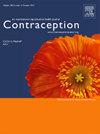机构和国家政策在不明地点怀孕管理中的作用:2024年美国瑞安计划的在线调查。
IF 2.8
2区 医学
Q1 OBSTETRICS & GYNECOLOGY
引用次数: 0
摘要
目的:评估国家和机构政策对美国Ryan住院医师项目管理不明地点妊娠(PUL)的感知影响。研究设计:我们在2024年3 - 4月对美国瑞安住院医师计划(n=113)进行了横断面电子调查。使用Guttmacher州堕胎限制分类,我们比较了在限制性和非限制性堕胎气候下,制度和国家政策对Ryan项目中PUL管理的感知影响。在PUL的检查中提供诊断性子宫抽吸是次要结果。我们用Fisher的精确测试比较了限制性和非限制性气候之间的反应比例。结果:我们从32个州的75个Ryan项目中获得了反馈(66.4%的回复率)。其中29例(38.7%)来自堕胎政策严格的州。8个项目(10.7%)在Dobbs决定后改变了PUL管理。与非限制性州的项目相比,限制性州的项目更有可能报告说,州政策“严重”或“某种程度上”抑制了他们照顾产后流产患者的能力(34.5% vs. 2.17%)。结论:州堕胎政策和机构政策可能会影响产后流产患者的选择。意义:所有立法机构的项目都应该解决提供子宫抽吸诊断的制度障碍。需要在限制国家进行立法宣传,以确保获得权宜之计的PUL管理。本文章由计算机程序翻译,如有差异,请以英文原文为准。
Role of institutional and state policies in management of pregnancies of unknown location: A 2024 online survey of Ryan Programs in the United States
Objective
This study aimed to assess the perceived impact of state and institutional policies on managing pregnancies of unknown location (PULs) at US Ryan residency programs.
Study design
We conducted a cross-sectional electronic survey of US Ryan residency programs (n = 113) from March to April 2024. We compared the perceived influence of institutional and state policies on PUL management among Ryan Programs in restrictive vs nonrestrictive abortion climates. Provision of diagnostic uterine aspiration in the workup of PUL was a secondary outcome. We compared proportion of responses between restrictive and nonrestrictive climates with Fisher exact tests.
Results
We obtained responses from 75 Ryan Programs in 32 states (66.4% response rate). 29 (38.7%) were from states with restrictive abortion policies. Eight programs (10.7%) changed PUL management after the Dobbs decision. Compared to programs in nonrestrictive states, programs in restrictive states were more likely to report that state policy inhibits their ability to care for patients with PUL (34.5% vs 2.17%, p < 0.001), rarely or never offer diagnostic uterine aspiration (34.5% vs 8.7%, p = 0.01), and identify institutional leadership as a barrier to offering diagnostic uterine aspirations (20.7% vs 2.2 %, p = 0.01). The most common institutional barriers to providing diagnostic uterine aspiration were staffing and faculty comfort/willingness, which did not differ by state abortion climate.
Conclusions
State abortion policy and institutional policy may impact the options available to patients with PULs.
Implications
Programs in all legislative climates should address institutional barriers to providing diagnostic uterine aspiration. Legislative advocacy in restrictive states is needed to ensure access to expedient PUL management.
求助全文
通过发布文献求助,成功后即可免费获取论文全文。
去求助
来源期刊

Contraception
医学-妇产科学
CiteScore
4.70
自引率
17.20%
发文量
211
审稿时长
69 days
期刊介绍:
Contraception has an open access mirror journal Contraception: X, sharing the same aims and scope, editorial team, submission system and rigorous peer review.
The journal Contraception wishes to advance reproductive health through the rapid publication of the best and most interesting new scholarship regarding contraception and related fields such as abortion. The journal welcomes manuscripts from investigators working in the laboratory, clinical and social sciences, as well as public health and health professions education.
 求助内容:
求助内容: 应助结果提醒方式:
应助结果提醒方式:


